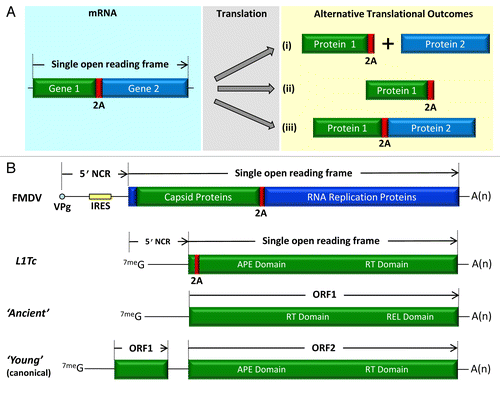Figures & data
Figure 1. Sequences encoding protein domains (or complete genes) can be concatenated via 2As to create a single ORF.Citation6-Citation10 The mRNA encodes a single ORF, translation potentially giving rise to three, alternative, products—depending upon the recoding activity of the 2A sequence in question. Outcome (i) corresponds to the production of two, individual, translation products—protein 1 with a C-terminal extension of 2A plus protein 2. Outcome (ii) arises from termination of translation at the C-terminus of 2A. Outcome (iii) produces a full-length translation product (A). The genomic organization of the picornavirus foot-and-mouth disease virus is shown (~8,500 nts). The 5′ terminus of the vRNA is covalently bound to an oligopeptide (VPg), rather than a 7meG mRNA cap structure. The long 5′NCR comprises an internal ribosome entry sequence (IRES) which initiates translation of the long ORF in a cap-independent manner. The capsid proteins polyprotein domain is separated from the replication protein domains by the recoding activity of 2A. The structure of the L1Tc transcript RNA is shown with the position of 2A in the N-terminal region of the ORF. For comparison, the equivalent RNA organisations are shown for the “ancient” type of non-LTR (a single ORF comprising RT and REL domains), together with the canonical “young” non-LTRS encoding 2 ORFs, in which the REL domain in ORF2 is supplanted by the APE domain (B).
